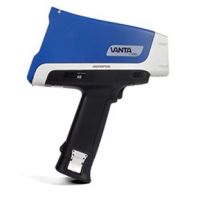Fuel Oil Requires Careful MonitoringOn-site testing of fuel oil has become an important task for machine and engine operators. Globally, stricter air pollution regulations require careful monitoring of sulfur content in fuels. In addition, the analysis of wear metals and fuel additives helps operators avoid costly downtime caused by engine failures. Energy-dispersive X-ray fluorescence (EDXRF), typically referred to as X-ray fluorescence or XRF, is a common technique used for these tasks. In simple terms, XRF is a nondestructive technique to measure the elemental composition in a sample. XRF was traditionally performed on benchtop systems, but today handheld XRF analyzers like our Vanta™ series are commonly used. |  Vanta handheld XRF analyzers provide rapid elemental analysis and alloy identification. |
The Experiment: Fuel Oil Analysis Using Handheld XRF Analyzers
To gauge how effective Vanta handheld XRF analyzers are at identifying various elements in oil samples, we ran an experiment. We used the analyzer to test certified reference material (CRMs) samples for oil screening (mineral-oil-based). Two sets of samples were prepared in a 100 ml plastic bottle with a Prolene window cap for analysis:
- Set 1: Wear metal and additive analysis
- CRMs spiked with varying contraptions of wear metal and additive element tests
- Set 2: Sulfur analysis
- Sulfur CRMs from 10 ppm to 10,000 ppm
- Verify against ASTM D4294 precision requirements
The Results
Our results demonstrated that handheld XRF can appropriately measure sulfur at low levels in accordance with ASTM D-4294 precision requirements. We also demonstrated that it can detect various wear metals and additive elements at low ppm levels—a performance that is comparable to several benchtop systems.
Here are some other key insights:
Wear Metals and Additives
- Overall effective for common transition metals
- Interelement interferences, such as nickel/iron/chromium interactions, will need to be considered when dealing with higher relative concentrations
- Methods for analysis recommend you consider interferences when interpreting/correcting result biases
Sulfur Analysis
- Effective at exciting and detecting sulfur per ASTM D4294 precision requirements
- Can easily measure well below the new IMO global and ECA limits
- Main concerns are around sample preparation and window contamination
- A single fingerprint can deposit >100 ppm of sulfur on your sample window, so careful handling and cleaning is recommended to reduce contamination
5 Important Takeaways About Fuel Oil Analysis Using Handheld XRF
To wrap up, here are five important conclusions:
- Overall, handheld XRF can rapidly screen for multiple elements of interest in both fuel and lubricating oils.
- Interferences need to be considered during analysis, as they may bias results. Follow method recommendations for bias and drift correction.
- Sample preparation is key. Improper sample handling can have a severe impact on results, particularly for lighter elements like sulfur (D4294 also warns about this).
- Handheld XRF is ultimately a screening tool. Some lab testing will still be merited where possible.
- As a best practice, always consider your testing goals and tolerance for risk when doing any regulatory-driven testing.
Make sure to subscribe to the InSight Blog (if you haven’t already!) to stay informed about the latest XRF and NDT technology.
Related Content
Analyzing Wear Metals and Additives in Oil and Fuel Using the VCA Model Vanta Analyzer
Meeting Strict Standards for Sulfur Content in Fuel with Vanta XRF Analyzers
Get In Touch

